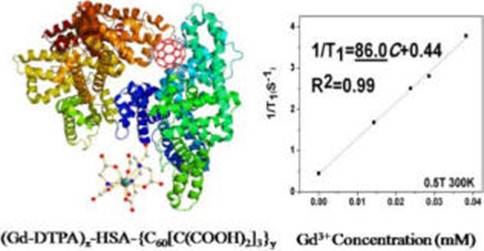Maximizing the Relaxivity of Gd-Complex by Synergistic Effect of HSA and Carboxylfullerene
Mingming Zhen,†,‡Junpeng Zheng,†,‡Lei Ye,†,‡Shumu Li,†,‡Chan Jin,∥Kai Li,§Dong Qiu,†Hongbin Han,§Chunying Shu,* ,†Yongji Yang,∥and Chunru Wang*
Macromolecular magnetic resonance imaging (MRI) contrast agent Gd-DTPA-HSA (DTPA, diethylene triamine pentacetate acid; HSA, human serum albumin) as a model has been successfully conjugated with trimalonic acid modi fi ed C60 for contrast enhancement at clinically used magnetic field strength. The Gd-DTPA-HSA-C60 conjugate exhibit maximal relaxivity (r 1 = 86 mM− 1s− 1at 0.5 T, 300 K) reported so far, which is much superior to that of the control Gd-DTPA-HSA (r 1 = 38 mM− 1s− 1) under thesame condition and comparable to the theoretical maximum (r 1 = 80 − 120mM− 1s− 1, at 20 MHz and 298 K), indicating the synergistic effect of HAS and carboxylfullerene on the increased contrast enhancement. TEM characterization reveals that both Gd-DTPA-HSA-C60 and Gd-DTPA-HSA can penetrate the cells via endocytosis and transmembrane, respectively, suggesting the potential to sensitively image the events at the cellular and subcellular levels. In addition, the fusion of fullerene with Gd-DTPA-HSA will further endow the resulting complex with photodynamic therapy (PDT) property and thus combine the modalities of therapy (PDT) and diagnostic imaging (MRI) into one entity. More importantly, the payloaded Gd-DTPA may substitute for other more stable Gd-DOTA and HSA as a theranostic package can further work as a drug delivery carrier and effectively control drug release through proteolysis.


